The curse becomes a blessing.
Ever had to run to the copier machine only to find it OUT OF SERVICE or even worse, LEFT JAMMED by a beloved co-worker!? Probably not, I suppose that only happens at my school and not at yours. Let me tell you, you are so fortunate. The many and extensive times this has happened to me, I have gotten so creative with my teaching, so in reality the frustration of the copy machine being broken has become a blessing because it has allowed me to think quick on my feet, roll with my class, and carry on with my lesson like Beyoncé on her best concert.
It doesn’t matter what is happening on a given day, we all know that our number one mission is to facilitate acquisition through the delivery of comprehensible input and we can do that in many ways through various activities even when all else (such as technology) may fail. Today, I want to share a couple of possible ideas that have worked for my classes far better than an already planned worksheet, all of these ideas involve a blank sheet of copy paper and a pair of scissors.
Benefits of Using Foldables in Class:
- Flexibility – you can adapt a foldable to literally anything you are already doing. Foldables are simply the vehicle you will use to bring your lesson to life while allowing students to organize the presented information. Foldables can be used to organize notes, to categorize information, to reflect, and analyze stories, novels, concepts, etc. What does this mean? It means that higher order thinking skills are being used in the classroom. You can literally ascend and descend on Bloom’s Taxonomy with foldables, it is up to you, the teacher. You are opening a unit and delivering compelling input? Use a foldable! You are going to give students opportunity to practice communication and want to give them a boost of confidence? (I sometimes may force output, but I see it more as a way to support my students when they are anxious to see how they can use the language) Use a foldable! You want to review a story? Use a foldable! You want students to analyze a chapter of a novel in a way it isn’t boring? Use a foldable! Need to have your middle school kiddos ready for next year’s grammar heavy language course as they start in their new high school (
a little secret…I first learned about foldables as a way to teach grammar…shhh)? Either way, use a foldable! - Serves as a graphic organizer – Need I say more? In case you do, this means that it has the potential to meet all learning modalities – auditory learners still have the opportunity to listen to you while delivering the lesson, kinesthetic learners will be involved by these as it turns other tasks into a more hands on process. Visual learners and specially the artistic ones will have blast with these.
- Students are more focused during the process – For this very reason, major opportunities for personalization and student ownership will arise. Many times, the information recorded on the foldable may differ depending on the student and the task. If this is the case, then the student is the driver of his/her own learning experience, and the foldables have the potential to give you a snapshot of the students’ progress.
- FOLDABLES ARE A NO PREP TOOL!
Materials Needed for All Foldables:
- copy paper
- scissors
Uses of Foldables:
- Straight up note taking
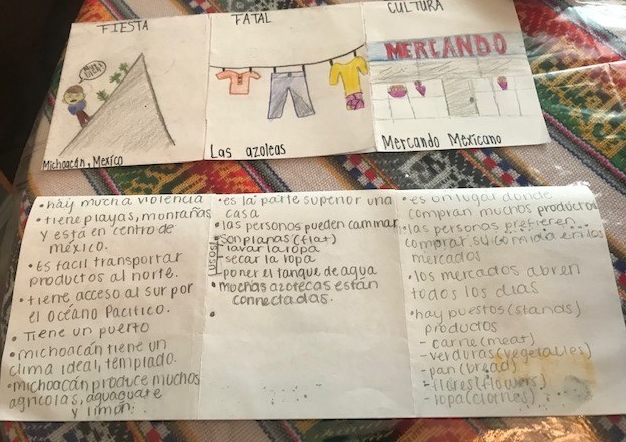 – As you are reading a novel or delivering compelling cultural input, simply instruct the students to fold the paper “hot dog” style. Then, fold and cut as many flaps as needed. Deliver input for each flap slowly. Pause after each section’s input has been delivered to allow students to illustrate the concepts.
– As you are reading a novel or delivering compelling cultural input, simply instruct the students to fold the paper “hot dog” style. Then, fold and cut as many flaps as needed. Deliver input for each flap slowly. Pause after each section’s input has been delivered to allow students to illustrate the concepts. - Scaffold speaking practice/tasks – Instruct students to cut “hot dog style,” then cut as many flaps according to the number of questions you w
 ill ask students to create. My directions with this activity are usually to come up with questions using targeted (or non targeted) vocabulary. Usually, after they have created their questions and sample responses, I lead the students to “level up” their responses by providing and brainstorming examples on the board. To read up on ways to level up in the WL classroom, visit Justin’s @Spanishplans blog post where he shares an amazing presentation to aid you in leading your students to “leveling up.”
ill ask students to create. My directions with this activity are usually to come up with questions using targeted (or non targeted) vocabulary. Usually, after they have created their questions and sample responses, I lead the students to “level up” their responses by providing and brainstorming examples on the board. To read up on ways to level up in the WL classroom, visit Justin’s @Spanishplans blog post where he shares an amazing presentation to aid you in leading your students to “leveling up.” - Four square story map – Initially, I got this idea from Martina Bex’s blog post when I was reading Esperanza by Carol Gaab. I use many of the Fluency Matters readers in my classroom.
 I love them because they are relevant to my students and they have amazing culture embedded within the stories not to mention that the study guides are so thorough. Usually, when I teach a novel for the first time, I am stalking every blog post relevant, and this is when I found Martina’s post thread on teaching with the novel Esperanza. In one of her posts, she suggested and provided a beautiful handout to create a four square story map.
I love them because they are relevant to my students and they have amazing culture embedded within the stories not to mention that the study guides are so thorough. Usually, when I teach a novel for the first time, I am stalking every blog post relevant, and this is when I found Martina’s post thread on teaching with the novel Esperanza. In one of her posts, she suggested and provided a beautiful handout to create a four square story map.  I used her template a couple of times and it was wonderful, but then I figured I could make a foldable out of it and save myself a trip to the copier machine here and there while allowing my students to get more creative if they so chose to do so. This is a great way to do a small review after reading a chapter or to open a lesson the day after.
I used her template a couple of times and it was wonderful, but then I figured I could make a foldable out of it and save myself a trip to the copier machine here and there while allowing my students to get more creative if they so chose to do so. This is a great way to do a small review after reading a chapter or to open a lesson the day after. - Analyzing text – So, this is where I started to get creative, well, not really. What really happened is that I took a lot of great ideas from different worksheets and past tasks/projects and made them work to help students understand text better via this type of foldable. There is something about giving them the power of choice and degree of creativity. They often continue to wow me with their products. This was also a foldable that students created after reading the Fluency Matters novel Felipe Alou.
 I simply created four categories for the students to write about in order to allow for more processing of input. In the # section, students had to write hashtags reacting to what they had read on that particular chapter. The other square was assigned to key words or new vocabulary for that chapter for which each students had to pick and choose. Additionally, there was a category for places and people, and one for dates as this chapter was heavy on dates. Finally, the last two flaps were assigned to write a summary (after I modeled via write and discuss) of the chapter along with a personal reaction to the chapter using trigger phrases such as “it surprised me that…,” “I already knew that…,” “It bothered me that…,” etc. This has also been a very successful foldable in my classes.
I simply created four categories for the students to write about in order to allow for more processing of input. In the # section, students had to write hashtags reacting to what they had read on that particular chapter. The other square was assigned to key words or new vocabulary for that chapter for which each students had to pick and choose. Additionally, there was a category for places and people, and one for dates as this chapter was heavy on dates. Finally, the last two flaps were assigned to write a summary (after I modeled via write and discuss) of the chapter along with a personal reaction to the chapter using trigger phrases such as “it surprised me that…,” “I already knew that…,” “It bothered me that…,” etc. This has also been a very successful foldable in my classes. - Practice Quizzes- Sometimes, it is better to have students produce quiz/test questions in order to help each other process the information after reading text independently or as a class.
 When I do this, I guide my students to create questions that are multi-leveled. I tell them to provide multiple choice questions, true or false questions, fill in the blank questions, and open ended questions. Of course they are also responsible to come up with an answer key. Upon completion of this foldable, they can quiz each other verbally or in written form in groups as they can trade their foldables to practice with several “quizzes.” A lot of the questions would be the same (nothing wrong with repetitio in the world of CI), but the question bank will be broad as well. If your class is competitive, you can even debate and vote about who created the most challenging quiz and why.
When I do this, I guide my students to create questions that are multi-leveled. I tell them to provide multiple choice questions, true or false questions, fill in the blank questions, and open ended questions. Of course they are also responsible to come up with an answer key. Upon completion of this foldable, they can quiz each other verbally or in written form in groups as they can trade their foldables to practice with several “quizzes.” A lot of the questions would be the same (nothing wrong with repetitio in the world of CI), but the question bank will be broad as well. If your class is competitive, you can even debate and vote about who created the most challenging quiz and why. - Grammar Foldables -I mentioned earlier that the first foldable I learned how to make was a foldable to facilitate grammar concept, verb charts to be exact. It has been two years since I became a proficiency based teacher, so I could not find any of my grammar chart foldables. However, I did find this particular one which I used in Spanish 1 a while ago to teach about writing description in the first and third person. In this type of foldable, illustrations are normally done on the outer part. This foldable could very well transform itself into a full blown verb chart if two more flaps are added on the top and the bottom.

 On the inside of this foldable, you can write notes on one section, provide sample sentences in another rectangle, and then have student create sentences of their own as well. Translations are always optional :).
On the inside of this foldable, you can write notes on one section, provide sample sentences in another rectangle, and then have student create sentences of their own as well. Translations are always optional :).
I am certain that there are a ton more ways to use them, but so far, these are the ways in which I have used them. Have you used foldables in your classroom? If so, how did it go? Do you have any idea to adapt and fit these into your teaching? As always, I would love to hear your thoughts.
Video Tutorial on how to cut foldables, click here.

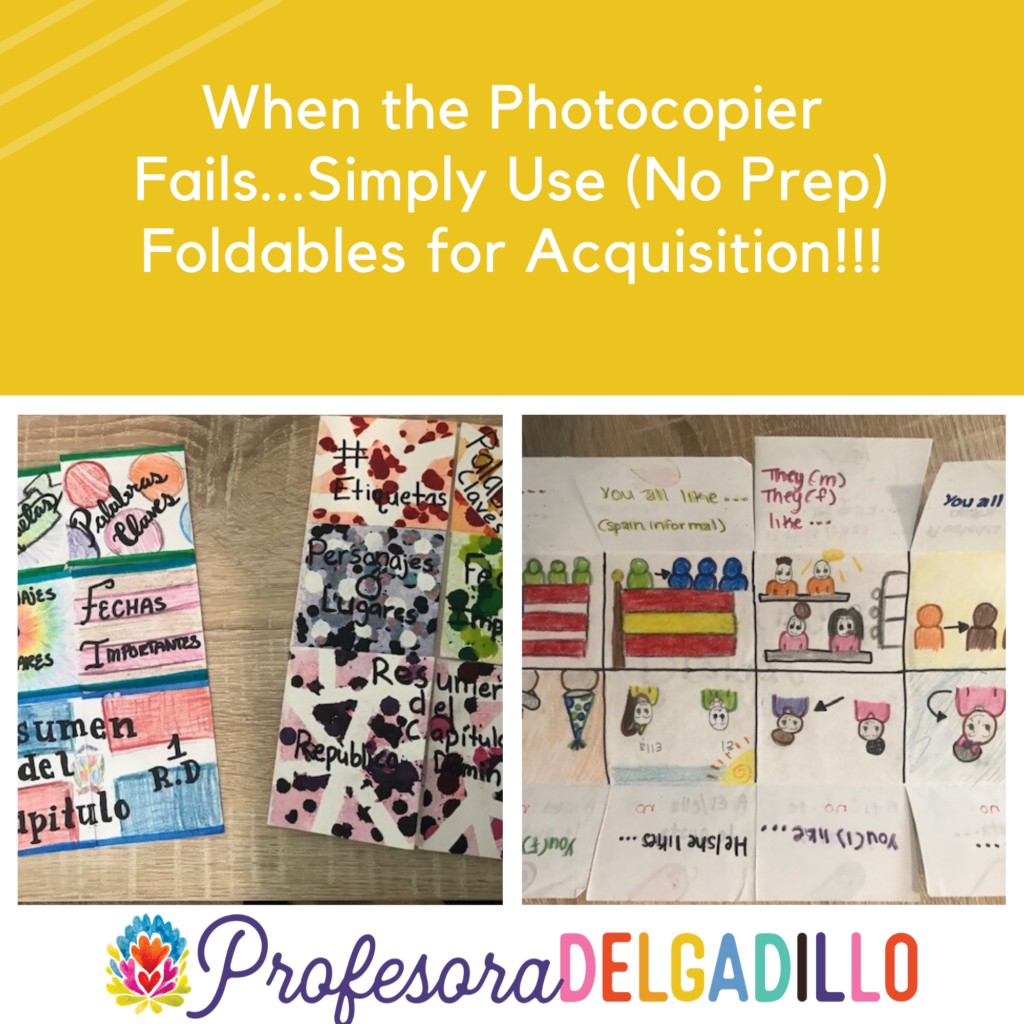
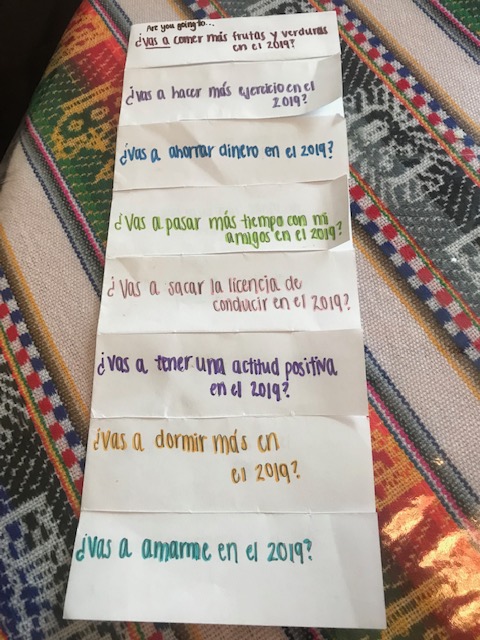 ill ask students to create. My directions with this activity are usually to come up with questions using targeted (or non targeted) vocabulary. Usually, after they have created their questions and sample responses, I lead the students to “level up” their responses by providing and brainstorming examples on the board. To read up on ways to level up in the WL classroom, visit Justin’s @Spanishplans blog
ill ask students to create. My directions with this activity are usually to come up with questions using targeted (or non targeted) vocabulary. Usually, after they have created their questions and sample responses, I lead the students to “level up” their responses by providing and brainstorming examples on the board. To read up on ways to level up in the WL classroom, visit Justin’s @Spanishplans blog 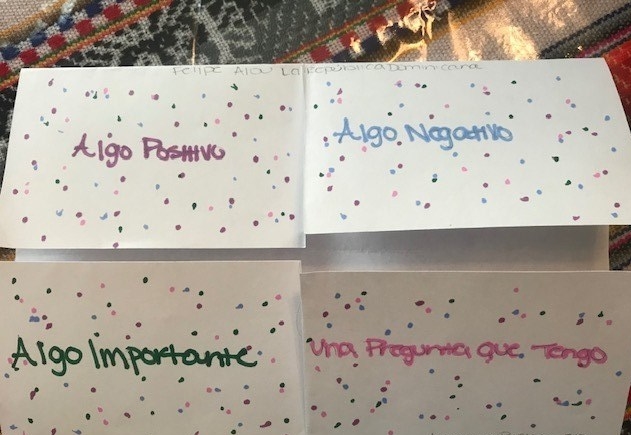 I love them because they are relevant to my students and they have amazing culture embedded within the stories not to mention that the study guides are so thorough. Usually, when I teach a novel for the first time, I am stalking every blog post relevant, and this is when I found Martina’s post thread on teaching with the novel Esperanza. In one of her
I love them because they are relevant to my students and they have amazing culture embedded within the stories not to mention that the study guides are so thorough. Usually, when I teach a novel for the first time, I am stalking every blog post relevant, and this is when I found Martina’s post thread on teaching with the novel Esperanza. In one of her  I used her template a couple of times and it was wonderful, but then I figured I could make a foldable out of it and save myself a trip to the copier machine here and there while allowing my students to get more creative if they so chose to do so. This is a great way to do a small review after reading a chapter or to open a lesson the day after.
I used her template a couple of times and it was wonderful, but then I figured I could make a foldable out of it and save myself a trip to the copier machine here and there while allowing my students to get more creative if they so chose to do so. This is a great way to do a small review after reading a chapter or to open a lesson the day after.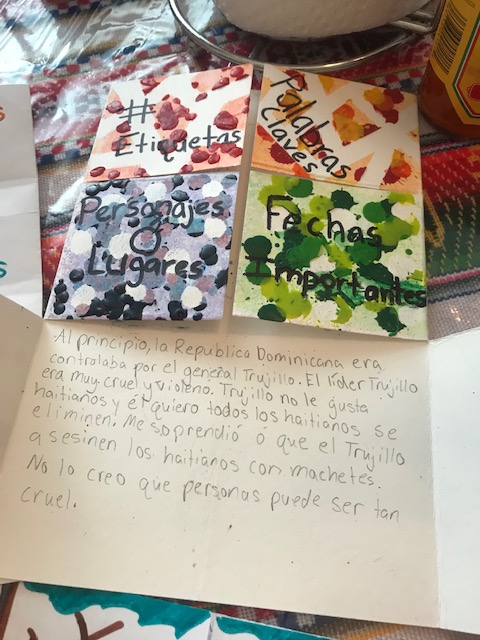 I simply created four categories for the students to write about in order to allow for more processing of input. In the # section, students had to write hashtags reacting to what they had read on that particular chapter. The other square was assigned to key words or new vocabulary for that chapter for which each students had to pick and choose. Additionally, there was a category for places and people, and one for dates as this chapter was heavy on dates. Finally, the last two flaps were assigned to write a summary (after I modeled via write and discuss) of the chapter along with a personal reaction to the chapter using trigger phrases such as “it surprised me that…,” “I already knew that…,” “It bothered me that…,” etc. This has also been a very successful foldable in my classes.
I simply created four categories for the students to write about in order to allow for more processing of input. In the # section, students had to write hashtags reacting to what they had read on that particular chapter. The other square was assigned to key words or new vocabulary for that chapter for which each students had to pick and choose. Additionally, there was a category for places and people, and one for dates as this chapter was heavy on dates. Finally, the last two flaps were assigned to write a summary (after I modeled via write and discuss) of the chapter along with a personal reaction to the chapter using trigger phrases such as “it surprised me that…,” “I already knew that…,” “It bothered me that…,” etc. This has also been a very successful foldable in my classes.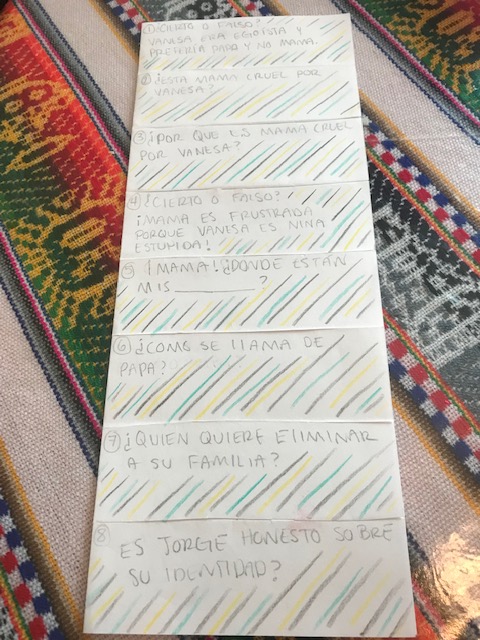 When I do this, I guide my students to create questions that are multi-leveled. I tell them to provide multiple choice questions, true or false questions, fill in the blank questions, and open ended questions. Of course they are also responsible to come up with an answer key. Upon completion of this foldable, they can quiz each other verbally or in written form in groups as they can trade their foldables to practice with several “quizzes.” A lot of the questions would be the same (nothing wrong with repetitio in the world of CI), but the question bank will be broad as well. If your class is competitive, you can even debate and vote about who created the most challenging quiz and why.
When I do this, I guide my students to create questions that are multi-leveled. I tell them to provide multiple choice questions, true or false questions, fill in the blank questions, and open ended questions. Of course they are also responsible to come up with an answer key. Upon completion of this foldable, they can quiz each other verbally or in written form in groups as they can trade their foldables to practice with several “quizzes.” A lot of the questions would be the same (nothing wrong with repetitio in the world of CI), but the question bank will be broad as well. If your class is competitive, you can even debate and vote about who created the most challenging quiz and why.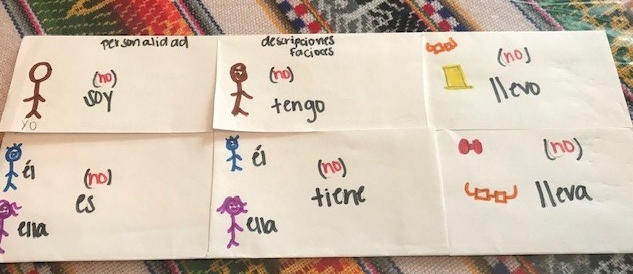
2 comments